When and how to plant peas in open ground: terms, rules for sowing and growing
Vegetable peas are one of those uncomplicated crops that you cannot do without in the country. It is remarkable in that its nutritional value is an order of magnitude higher than all vegetables. In addition, it contains a special balance of vitamins, sugars, amino acids and trace elements. That is why you don't get fat and thin with it.
In cultivation, peas are no more whimsical than any other early vegetable crop from the group of cold-resistant plants. In any case, even a novice summer resident who is addicted to this vegetable bean plant can grow it without problems.
Read the recommendations for the technology of planting peas in open ground, with the features of proper care and proper collection for storage, and no difficulties will confuse you.
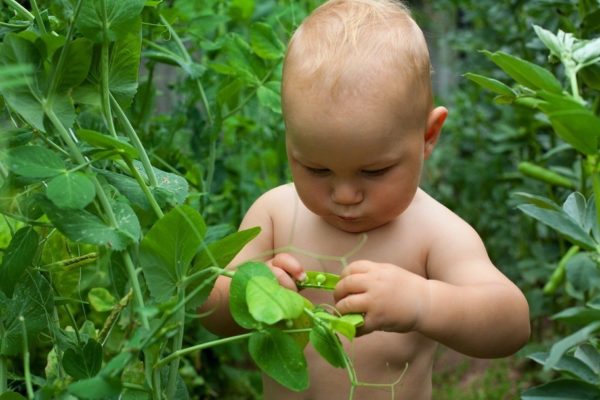
Content
Pea varieties
Pea varieties are usually divided into 2 directions:
- Peeling (Atlant, Vera, Alpha, Premium, Avola, Voskhod, Viola, Adagumsky, Grasshopper, Early Gribovsky).
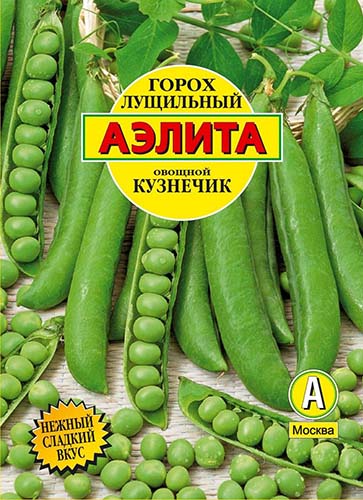
- Sugar (Oscar, Candy, Giant, Ambrosia, Bastion, President, Inexhaustible 195, Amicable, Swiss giant, Everest, Senator).
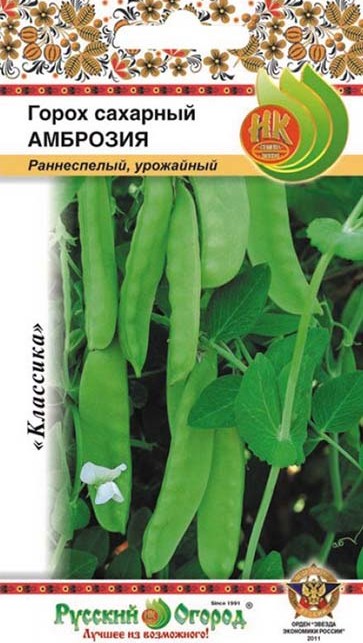
The external difference is that the peeling varieties are usually small bushes, while the sugar ones are quite tall.
The taste differences are that sugar varieties can be eaten with the shells (they are very sweet), whereas they are not eaten at shelling shells, but the peas themselves are much sweeter. Sugar varieties, for the most part, are grown in order to consume them immediately, but shelling ones are well suited for storage and preservation.
When to sow peas in open ground: optimal timing
Peas are very easy to grow. It tolerates frosts down to -5 ..- 8 degrees. Therefore, it should be planted as early as possible, as soon as the soil thaws, without even waiting for the return frosts to pass, of course, depending on the climatic characteristics of your region of residence. Peas are very fond of water, and the earth is moist at this time, and this just contributes to its better germination.
As for the specific dates for planting peas in open ground, you can start sowing it from the second half of March or from the beginning of April. Respectively:
- in warm southern regions (in the Krasnodar Territory, in the Kuban), you can plant as early as March;
- but in colder areas, for example, in the Middle Strip (Moscow region), the Leningrad region, in the Urals and in Siberia, it is better to postpone the planting of peas until April-May.
Idea! In general, you can plant peas in the garden in several stages, including in early summer and even in July. Of course, these must be early maturing varieties.
According to the lunar calendar in 2020
According to the lunar calendar in 2020, the following dates are favorable days for planting peas in open ground in spring:
- in April - 1, 2, 9-11, 13-15, 24-27;
- in May - 2-6, 25-31;
- in June - 1-4, 7-9.

In fact, it is not so scary if you plant peas on other days, the main thing is not to plant on unfavorable dates according to the lunar calendar (the days of the Full Moon and New Moon, as well as the period when the Moon is in Aquarius, because it is barren and dry sign -italicized), and this is in 2020:
- in April - 8,15-17, 23;
- in May - 7,13-14, 22;
- in June - 5,9-11, 21.
According to the lunar calendar from the magazine "1000 Tips for Summer Residents".
Pea planting technology in open ground
So, if you want to do everything according to science, then before you directly plant the peas in the ground, you need to carry out several preparatory measures.
Processing peas before planting
Before planting peas in open ground, it is recommended to pre-soak and germinate them for earlier germination.
If you are using your own seeds, then it is advisable to process such peas before planting by immersing them in a salt solution (based on 30 grams of salt per 1 liter of water) for five to ten minutes. The seeds that float are most likely affected by the pea weevil, they should be thrown out, and those that sink to the bottom should be rinsed with water and then soaked according to the instructions below.

Soaking peas is carried out as follows: pour peas into a deep plate, pour water about 1 cm higher than peas and leave until morning, that is, about 10-12 hours. Until the morning, the peas swell and collect water. Now they need to germinate for earlier germination. To do this, rinse the swollen peas under running water, and then wrap them in gauze or cloth bags and put them in a plastic bag until germination, that is, for about 2 days at a warm (room) temperature. It is advisable to take out the peas 1-2 times a day and rinse them with water so that mucus or decay does not form.
If suddenly the weather is not conducive to sowing, then such peas can be stored in the refrigerator for several weeks, and the sprouts will germinate, but not outgrow.
To disinfect the planting material, you can hold the peas in a weak solution of potassium permanganate for 15 minutes.
Note! There is also pelleted pea seeds, which do not need to be specially prepared or germinated, they have already been processed by the manufacturer, they must be sown immediately into the ground.
Video: soaking peas before planting to accelerate growth
Choosing a place for a garden and preparing the soil
When choosing a place for a garden bed for planting peas in a summer cottage, it is recommended to choose the most sunny and most protected from the wind place.
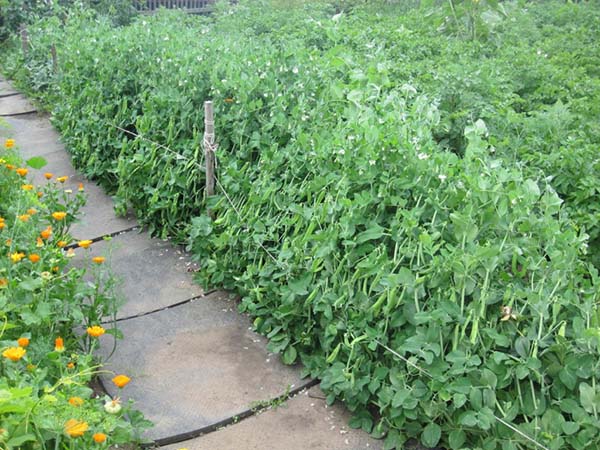
Good precursors for planting peas are cucumbers, cabbage, potatoes and pumpkin, in other words, beds where organic matter was previously abundantly applied, and even better - phosphorus-potassium fertilizers.
Note! It is advisable to plant peas in the same place no earlier than after 4-5 years.
Preparing a garden bed is quite simple: you need to remove all weeds, dig up and loosen all the soil, and then apply fertilizer. However, it is important not to overfeed the soil with fertilizers. When planting, only a little high-quality humus or compost should be introduced into the groove. If the soil is overfed, then you will receive an abundance of green mass to the detriment of the peas themselves.
If you have a heavy (clay) soil that cannot be called fertile, then you should still add a little fertilizer to it. On fertile soils, peas are capable of producing nitrogen themselves, accumulating it on the tips of their roots, but only after the formation of nodules.
In general, it is believed that the quality of the land for peas is not of fundamental importance. After all, this culture, according to experts of vegetable growers, is almost the best predecessor for absolutely all crops, except, of course, the legumes themselves. That is, if you want to revive or improve the soil, you still think what siderat plant, then peas are ideal. Not only will you enrich the soil with nitrogen, but you will also get delicious pea beans.
Landing in the ground
You need to plant peas according to the following scheme: the distance between the rows is 50-60 centimeters (at least 30 centimeters if you have a lack of space in your summer cottage), between the peas themselves - 4-6 centimeters, the planting depth is up to 3 centimeters, depending on the soil: if it is light, then - 2-3 centimeters, if heavy (clay) - 3-4 centimeters.
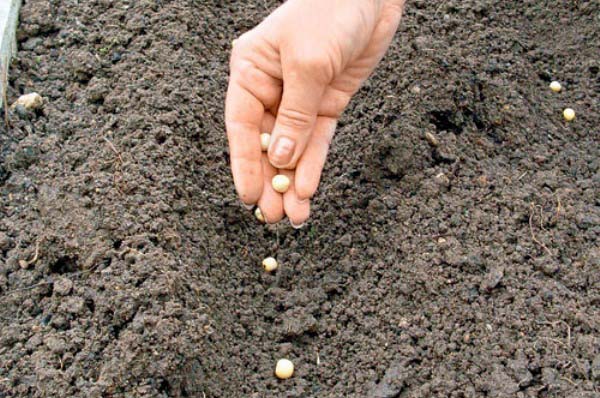
Step-by-step instructions for planting sprouted peas in open ground:
- Soak and germinate the planting material. Some growers are planted with dry seeds. What to do - every gardener decides independently through trial and error on his site.
- Prepare the bed and make grooves.
- Place a small layer of humus or compost in the grooves (optional or if you have very poor soil).
- Sow peas according to the recommended pattern. It is not forbidden if you plant the peas in one groove in a checkerboard pattern. With this planting, the peas will support themselves when they grow up.
- Cover with earth and be sure to slightly compact.
- Cover the bed with a covering material, for example, agril, otherwise all your plantings will be raked and pecked by birds.
Video: planting sprouted peas in the ground
Video: planting peas with dry seeds
Outdoor pea care
Important! It is advisable to prepare structures for garters of future pea shoots immediately after sowing. To do this, you can drive in the pegs and pull the rope, or you can install a special metal mesh. If you do not tie it up, the wind and rain will simply knock the bushes to the ground, and the yield will decrease.
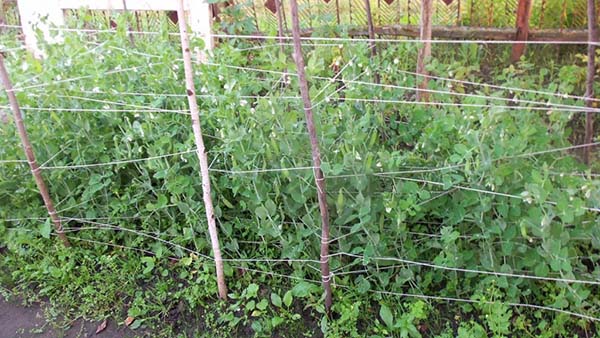
The first friendly sprouts of peas, as a rule, you will be able to observe in 1-2 weeks.

The most important thing in pea care is watering. If you have dry weather, then the plant must be watered often and abundantly, at least once every 5-6 days. After each watering, do not forget to immediately loosen the ground, and also periodically weed from weeds. Such a procedure will be good for the development of the peas.It is especially important to pay attention to watering during the flowering period and during the beginning of the appearance (setting) of the first fruits.
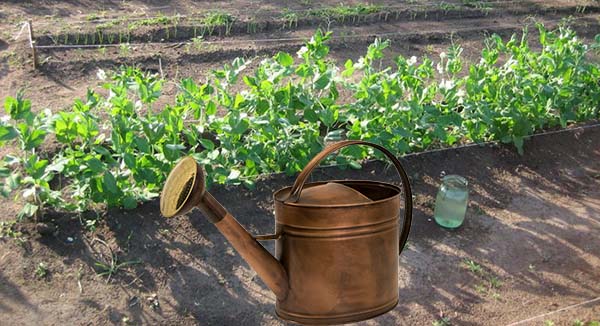
The most important secret to get large, sweet and soft peas is when the peas start to bloom, feed them wood ash (potash fertilizer). The solution can be made in this way: 200-300 grams of ash (this is about 2-3 glasses) per 10 liters of water. You can also use green fertilizer (herbal infusion) for feeding.
Video: all about growing peas
Pest and disease control
The most vicious pest of peas is the pea moth (leaf roll), which lays its eggs right on the green bushes, from which caterpillars then appear, which climb inside the pods and eat the peas. Also, your crops may be attacked by pea aphids.

There are several ways to deal with pea pests:
- When planting peas, you can sow white mustard.
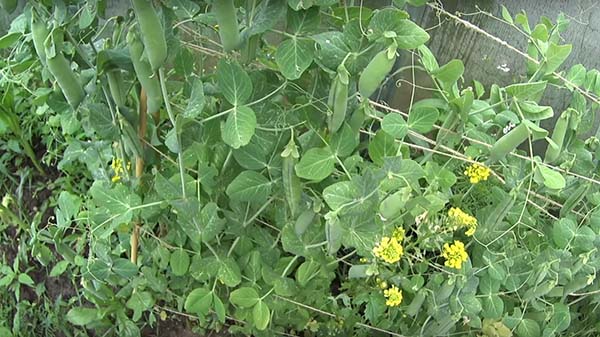
- It is also very good to add a little hot red pepper into the grooves when sowing.
- If the pest appears, then it is worth trying to sprinkle the plant with an infusion of tomato tops (at the rate of 3 kg of tops per bucket of water, insist for 1-2 days).
- You can process the pea plantings with garlic infusion (at the rate of 20 grams of grated garlic per bucket of water, insist for a day).
Peas collection and storage
It is customary to harvest peas in about 2-4 weeks after flowering. The lower pods ripen earlier than the upper ones. The pods are removed every 2-3 days.

By the way! Harvesting on time can even help increase the yield of your peas. On the contrary, if you are late, it will slow down the ripening of the next pods, and the grains themselves will begin to coarse.
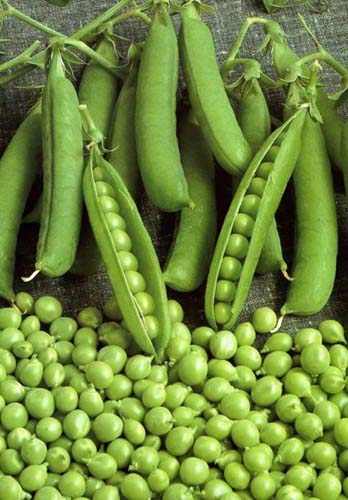
You can also leave the peas ripe for seeds. To collect the peas for seeds, you should wait until the pods turn yellow completely, dry up a little and "ring" in the pod.
Video: when and how to collect pea seeds for subsequent planting
There are several ways to store peas. Freezing and canning are great for this. Although you can just dry it.

Worth knowing! If you want the pea grains not to lose their qualities (sugar, amino acids and vitamins), then immediately (within 2-4 hours) after harvesting they must be dried, preserved or frozen.
It is advisable to store dried peas in glass jars, closed and in dark places. Storage under such conditions will prevent all kinds of worms and insects from appearing in peas.
Thus, if you "fall ill" with such a respectable vegetable crop as peas, and strive to learn how to grow it correctly, use the tips and advice on progressive agricultural techniques for planting peas in open ground, collecting them for storage, and they will help even a novice summer resident, do not multiply mistakes, to achieve an exceptional harvest on your site.
Video: briefly about growing peas

